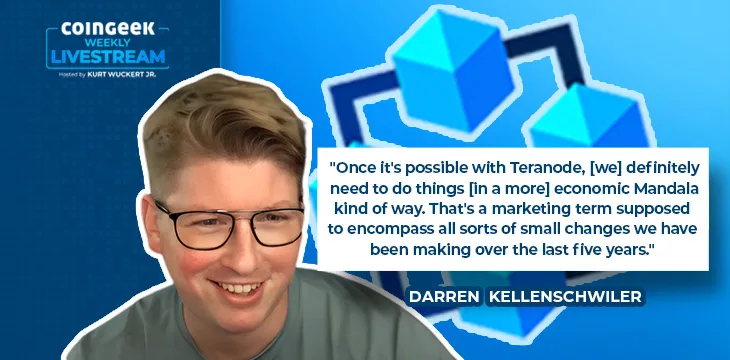
|
Getting your Trinity Audio player ready... |
On episode 24 of the CoinGeek Weekly Livestream Season 4, Darren Kellenschwiler from the BSV Association joined Kurt Wuckert Jr. to talk about the latest developments on the BSV blockchain.
Blockchain isn’t new technology
Wuckert kicks things off by pointing viewers to his latest CoinGeek article: Blockchain isn’t new technology. In it, he explains how there were many digital currencies before Bitcoin and how its unique contribution was its competitive consensus model.
While blockchain is a highly efficient, game-changing technology, its potential has been deliberately handicapped and hidden by vested interests and rent seekers. Fast, efficient, and scalable blockchains like BSV exemplify this potential; hence why they are maligned and hated by many, both inside and outside the crypto industry.
Darren Kellenschwiler and what he does at the BSVA
Kellenschwiler has worn several hats in the BSV ecosystem. He used to work for Elas Digital, but now he’s a Technical Lead at the BSV Association and handles basically everything other than Teranode. He’s a long-time software developer and BSV builder.
Wuckert asks what has changed in BSV since 2020. He wonders, if Kellenschwiler had to convince someone who left back then to come back, what would he say? Back then, everyone was trying to sell shovels and be the platform everyone else built on, he answers. That’s Web 2.0 thinking; he thinks the future will be more decentralized. Wuckert seconds this and emphasizes open protocols, which he has written about and mentioned many times before.
Kellenschwiler says it would be helpful if we agreed to do things the same way. That’s where the BSV Association comes in; it’s building the foundations everyone can build on without subsequently owning everything. Everything is proceeding under the working assumption that SV Node disappears completely ushering in the Teranode era, and the devs are aware of that. Kellenschwiler himself is tasked with clarifying things, giving them names, etc.
Liteclient, overlays, BRCs, BEEF, etc.
Wuckert wants to dive deeper into some of the concepts Kellenschwiler is talking about. He starts with BEEF, which is the Background Evaluation Extended Format. This allows a transaction to include some data from a previous one, meaning it doesn’t have to be given to Teranode. They can also be sent to ARC in an extended format, providing an early warning about whether there are any problems with the transaction structure.
Talking about BRCs, Kellenschwiler says the rules of contribution are in a repository. Anyone can post issues for discussion, make pull requests, etc., on GitHub. A few people have the power to merge or control all of this, but the BSVA is the ultimate arbiter.
Moving on to overlay networks, Kellenschwiler describes them as a higher level of abstraction over the underlying network. Overlay designers can set their own rules and ingest BSV transactions that meet those rules.
There are now SDK libraries for TypeScript, Python, and GO, and there may soon be a Rust one. The target market for these is people looking to build something new and special. Having these reduces the cognitive load put on BSV developers.
Is BSV the only blockchain capable of tokenizing the entire financial system?
A viewer asks this question, and Kellenschwiler responds in the affirmative. You need many Bits to cover everything, and there’s an economic element, too. IPv6 will help by making more unique addresses available and offering greater efficiency.
Watch: Rallying for diversity in blockchain

 11-21-2024
11-21-2024


